Abstract
The metabolism of pentose-phosphate was investigated in Plasmodium falciparum-infected normal and glucose-6-phosphate dehydrogenase (G6PD)-deficient human red blood cells in vitro. 5'-Phosphoribosyl-1-pyrophosphate (PRPP) content of infected normal red blood cells was increased 50-60-fold at the parasite trophozoite growth stage over that of uninfected cells. The PRPP increment in infected G6PD-deficient cells at comparable stage and parasitemia was only 40% of the value in normal infected cells. Red blood cell PRPP synthetase activity did not change during the growth cycle of the parasite and was similar in both normal and G6PD-deficient cells. Reduced glutathione (GSH) content of G6PD-deficient cells under conditions of culture fell to low or undetectable levels. These low levels of GSH were shown to inhibit the function of red blood cell PRPP synthetase, which requires GSH for full activity. Measurements of the incorporation of 1-14C or 6-14C selectively labeled glucose into parasite nucleic acids revealed that in normal infected red cells, approximately 20% of the pentose was produced via the oxidation of glucose-6-phosphate, whereas in infected G6PD-deficient cells (Mediterranean type), none of the pentose was produced via the oxidative pathway. It is concluded that the low level of reduced GSH found in G6PD deficiency and the resultant partial inhibition of PRPP synthetase together with the missing oxidative pathway for ribose phosphate production can account fully for the reduced parasite growth rate in G6PD-deficient red blood cells described previously. Of these two mechanisms, the predominant one is the impaired PRPP synthetase activity due to low GSH levels in enzyme-deficient red blood cells. The contribution to the ribose-phosphate pool by the hexose monophosphate shunt is relatively minor. A co-existing oxidative stress (which is often hypothesized to mediate the destruction of parasitized red blood cells) is not required to explain growth inhibition in this scheme and does not represent the most straight-forward explanation of the data described in this report.
Full text
PDF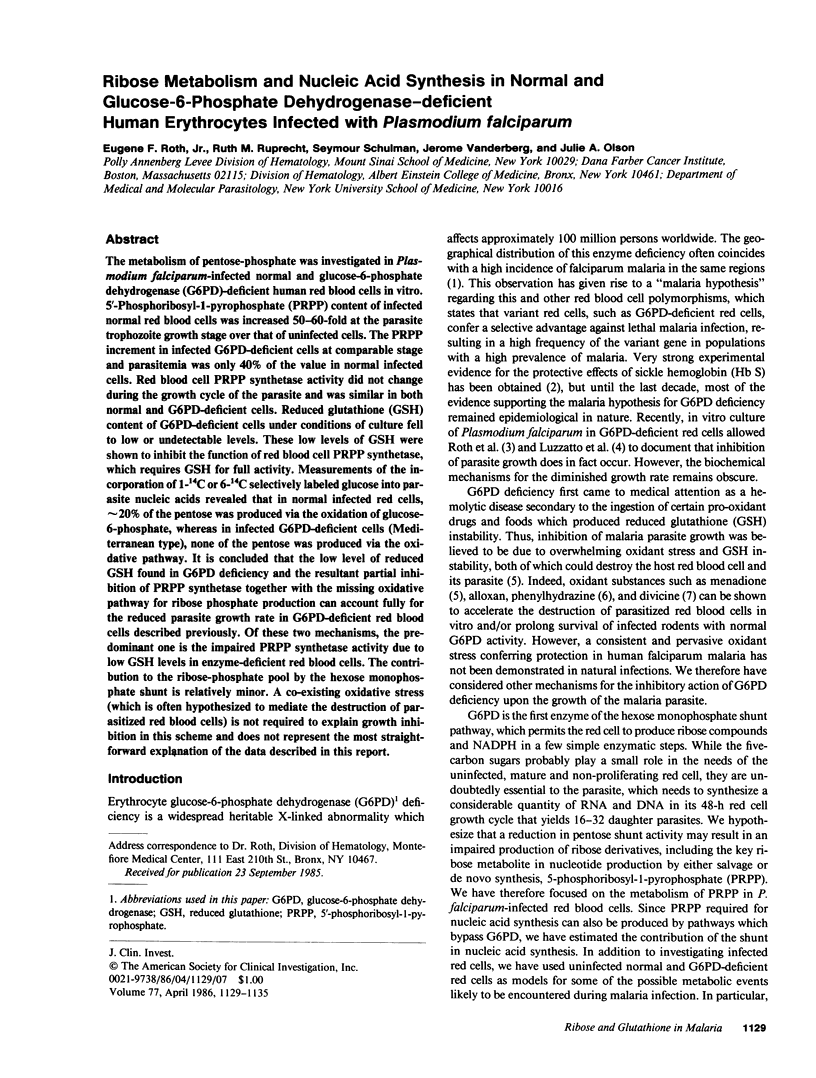
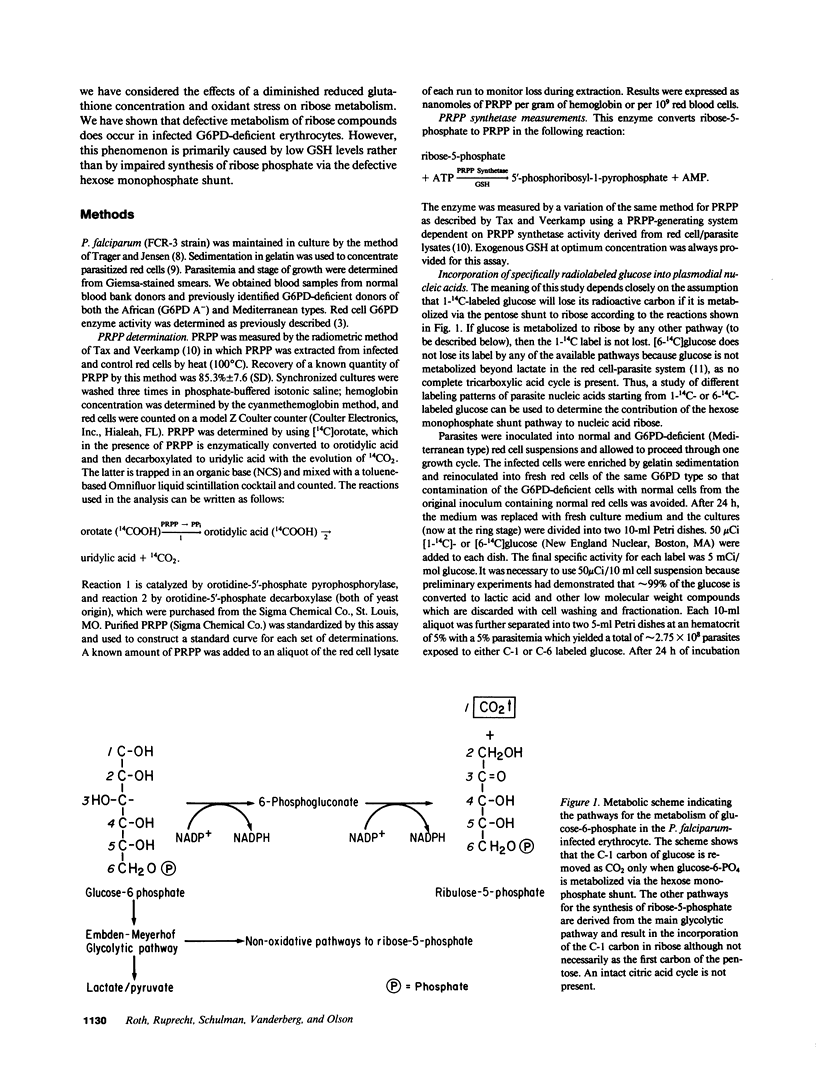
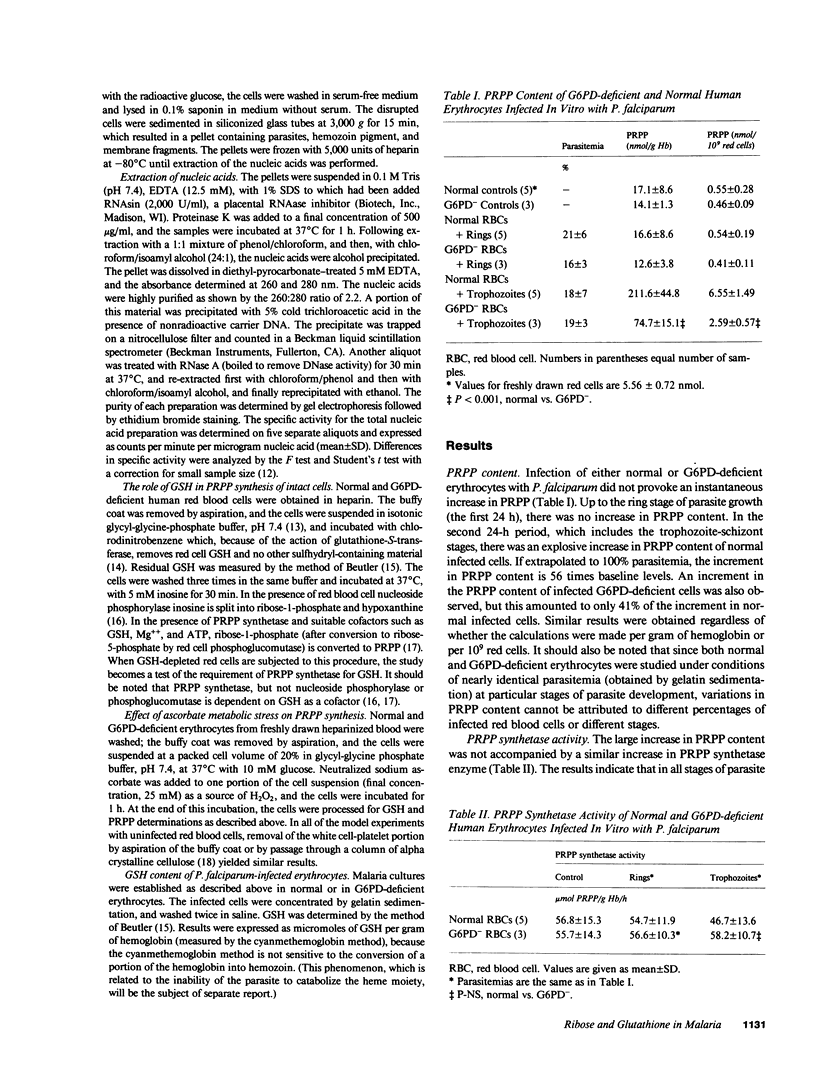
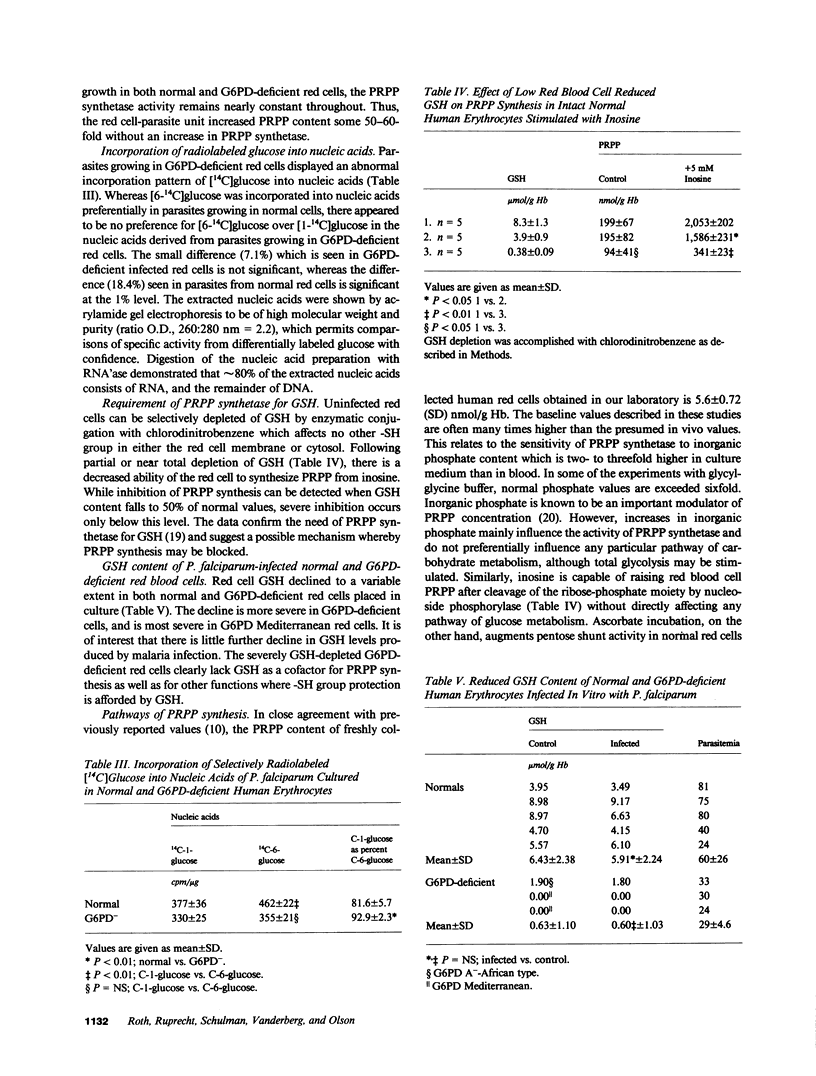
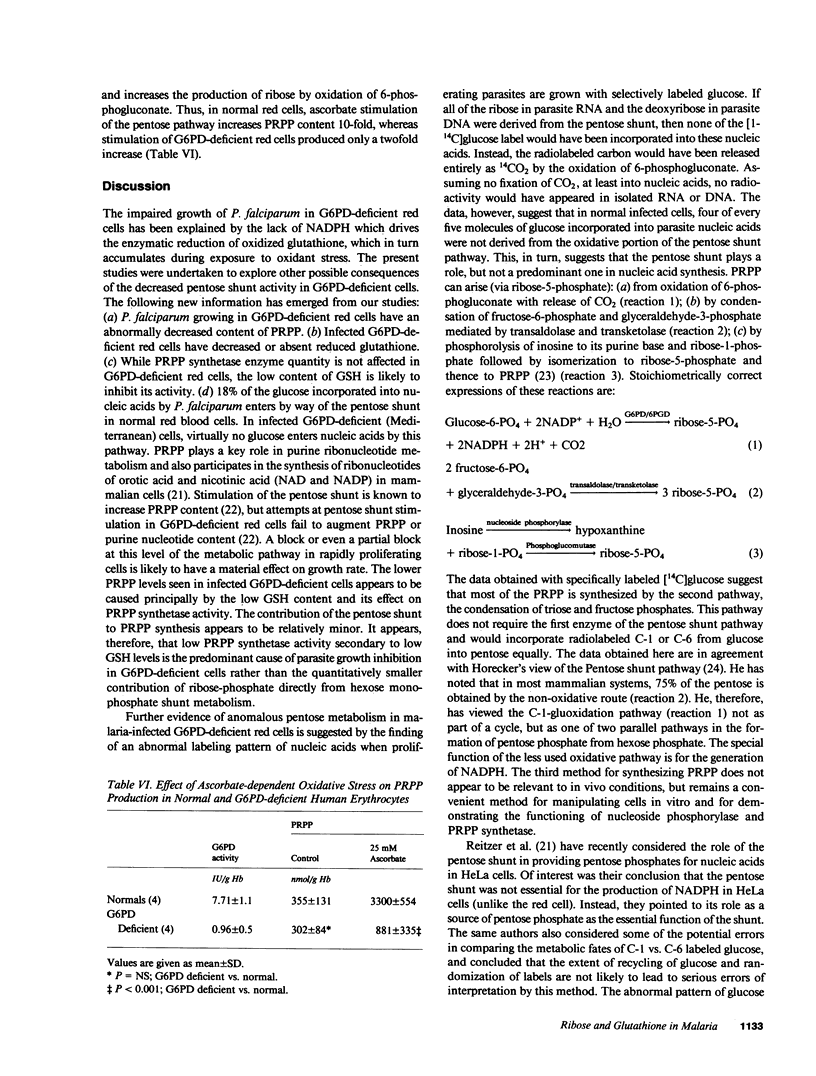
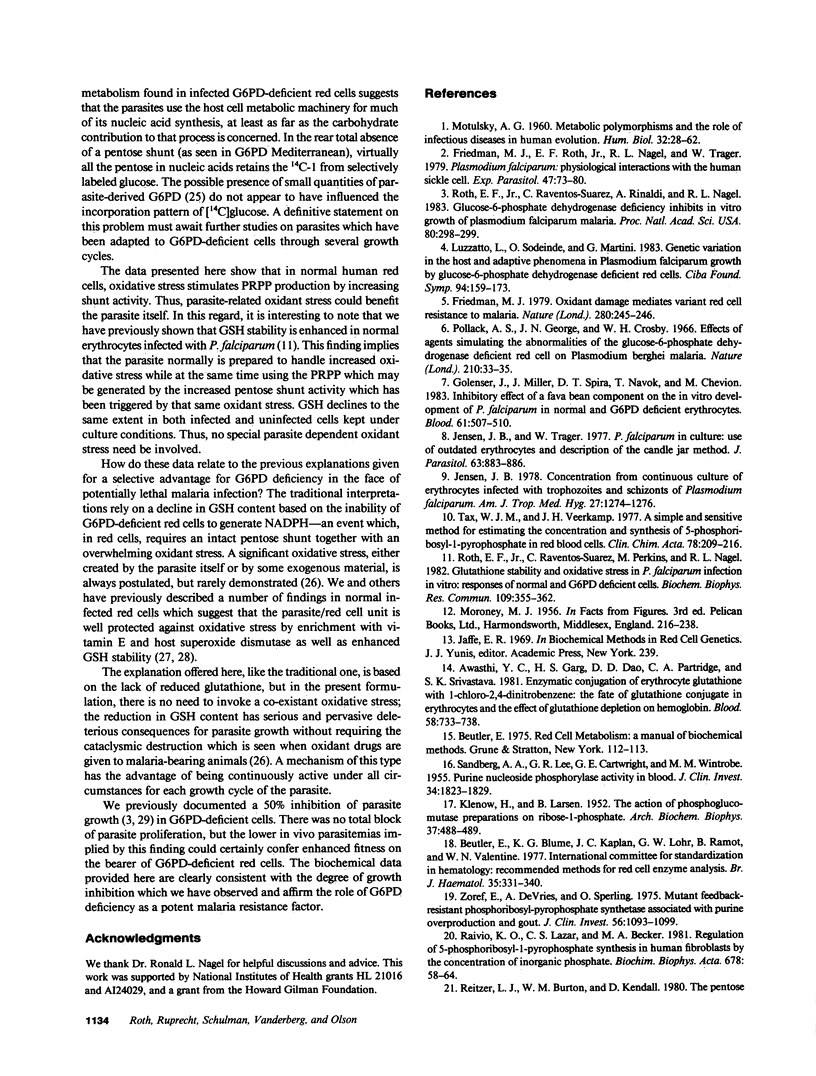
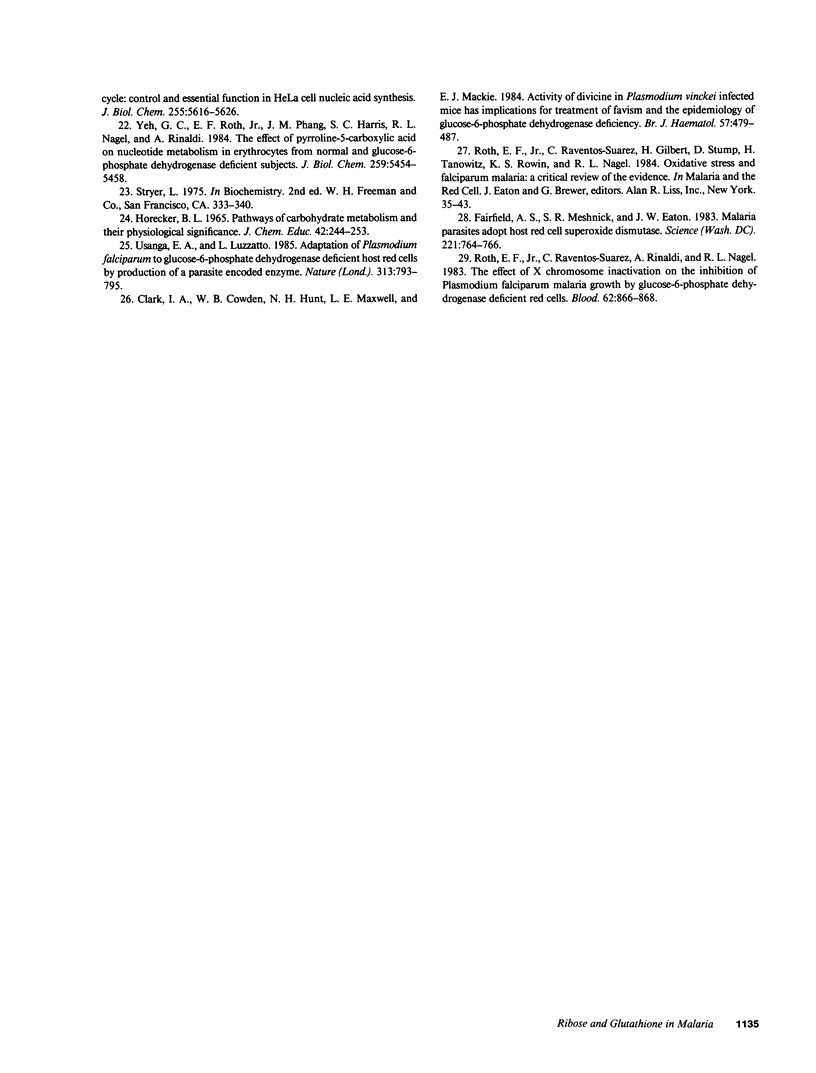
Selected References
These references are in PubMed. This may not be the complete list of references from this article.
- Awasthi Y. C., Garg H. S., Dao D. D., Partridge C. A., Srivastava S. K. Enzymatic conjugation of erythrocyte glutathione with 1-chloro-2,4-dinitrobenzene: the fate of glutathione conjugate in erythrocytes and the effect of glutathione depletion on hemoglobin. Blood. 1981 Oct;58(4):733–738. [PubMed] [Google Scholar]
- Beutler E., Blume K. G., Kaplan J. C., Löhr G. W., Ramot B., Valentine W. N. International Committee for Standardization in Haematology: recommended methods for red-cell enzyme analysis. Br J Haematol. 1977 Feb;35(2):331–340. doi: 10.1111/j.1365-2141.1977.tb00589.x. [DOI] [PubMed] [Google Scholar]
- Clark I. A., Cowden W. B., Hunt N. H., Maxwell L. E., Mackie E. J. Activity of divicine in Plasmodium vinckei-infected mice has implications for treatment of favism and epidemiology of G-6-PD deficiency. Br J Haematol. 1984 Jul;57(3):479–487. doi: 10.1111/j.1365-2141.1984.tb02922.x. [DOI] [PubMed] [Google Scholar]
- Fairfield A. S., Meshnick S. R., Eaton J. W. Malaria parasites adopt host cell superoxide dismutase. Science. 1983 Aug 19;221(4612):764–766. doi: 10.1126/science.6348944. [DOI] [PubMed] [Google Scholar]
- Friedman M. J. Oxidant damage mediates variant red cell resistance to malaria. Nature. 1979 Jul 19;280(5719):245–247. doi: 10.1038/280245a0. [DOI] [PubMed] [Google Scholar]
- Friedman M. J., Roth E. F., Nagel R. L., Trager W. Plasmodium falciparum: physiological interactions with the human sickle cell. Exp Parasitol. 1979 Feb;47(1):73–80. doi: 10.1016/0014-4894(79)90009-2. [DOI] [PubMed] [Google Scholar]
- Golenser J., Miller J., Spira D. T., Navok T., Chevion M. Inhibitory effect of a fava bean component on the in vitro development of Plasmodium falciparum in normal and glucose-6-phosphate dehydrogenase deficient erythrocytes. Blood. 1983 Mar;61(3):507–510. [PubMed] [Google Scholar]
- HORECKER B. L. PATHWAYS OF CARBOHYDRATE METABOLISM AND THEIR PHYSIOLOGICAL SIGNIFICANCE. J Chem Educ. 1965 May;42:244–253. doi: 10.1021/ed042p244. [DOI] [PubMed] [Google Scholar]
- Jensen J. B. Concentration from continuous culture of erythrocytes infected with trophozoites and schizonts of Plasmodium falciparum. Am J Trop Med Hyg. 1978 Nov;27(6):1274–1276. doi: 10.4269/ajtmh.1978.27.1274. [DOI] [PubMed] [Google Scholar]
- Jensen J. B., Trager W. Plasmodium falciparum in culture: use of outdated erthrocytes and description of the candle jar method. J Parasitol. 1977 Oct;63(5):883–886. [PubMed] [Google Scholar]
- KLENOW H., LARSEN B. The action of phosphoglucomutase preparations on ribose 1-phosphate. Arch Biochem Biophys. 1952 Jun;37(2):488–490. doi: 10.1016/0003-9861(52)90209-9. [DOI] [PubMed] [Google Scholar]
- Luzzatto L., Sodeinde O., Martini G. Genetic variation in the host and adaptive phenomena in Plasmodium falciparum infection. Ciba Found Symp. 1983;94:159–173. doi: 10.1002/9780470715444.ch10. [DOI] [PubMed] [Google Scholar]
- MOTULSKY A. G. Metabolic polymorphisms and the role of infectious diseases in human evolution. Hum Biol. 1960 Feb;32:28–62. [PubMed] [Google Scholar]
- Pollack S., George J. N., Crosby W. H. Effect of agents simulating the abnormalities of the glucose-6-phosphate dehydrogenase-deficient red cell on Plasmodium berghei malaria. Nature. 1966 Apr 2;210(5031):33–35. doi: 10.1038/210033a0. [DOI] [PubMed] [Google Scholar]
- Raivio K. O., Lazar C. S., Becker M. A. Regulation of 5-phosphoribosyl-1-pyrophosphate synthesis in human fibroblasts by the concentration of inorganic phosphate. Biochim Biophys Acta. 1981 Nov 18;678(1):58–64. doi: 10.1016/0304-4165(81)90047-7. [DOI] [PubMed] [Google Scholar]
- Reitzer L. J., Wice B. M., Kennell D. The pentose cycle. Control and essential function in HeLa cell nucleic acid synthesis. J Biol Chem. 1980 Jun 25;255(12):5616–5626. [PubMed] [Google Scholar]
- Roth E. F., Jr, Raventos Suarez C., Rinaldi A., Nagel R. L. The effect of X chromosome inactivation on the inhibition of Plasmodium falciparum malaria growth by glucose-6-phosphate-dehydrogenase-deficient red cells. Blood. 1983 Oct;62(4):866–868. [PubMed] [Google Scholar]
- Roth E. F., Jr, Raventos-Suarez C., Perkins M., Nagel R. L. Glutathione stability and oxidative stress in P. falciparum infection in vitro: responses of normal and G6PD deficient cells. Biochem Biophys Res Commun. 1982 Nov 30;109(2):355–362. doi: 10.1016/0006-291x(82)91728-4. [DOI] [PubMed] [Google Scholar]
- Roth E. F., Jr, Raventos-Suarez C., Rinaldi A., Nagel R. L. Glucose-6-phosphate dehydrogenase deficiency inhibits in vitro growth of Plasmodium falciparum. Proc Natl Acad Sci U S A. 1983 Jan;80(1):298–299. doi: 10.1073/pnas.80.1.298. [DOI] [PMC free article] [PubMed] [Google Scholar]
- Roth E., Jr, Raventos-Suarez C., Gilbert H., Stump D., Tanowitz H., Rowin K. S., Nagel R. L. Oxidative stress and falciparum malaria: a critical review of the evidence. Prog Clin Biol Res. 1984;155:35–43. [PubMed] [Google Scholar]
- SANDBERG A. A., LEE G. R., CARTWRIGHT G. E., WINTROBE M. M. Purine nucleoside phosphorylase activity of blood. I. Erythrocytes. J Clin Invest. 1955 Dec;34(12):1823–1829. doi: 10.1172/JCI103238. [DOI] [PMC free article] [PubMed] [Google Scholar]
- Tax W. J., Veerkamp J. H. A simple and sensitive method for estimating the concentration and synthesis of 5-phosphoribosyl 1-pyrophosphate in red blood cells. Clin Chim Acta. 1977 Jul 15;78(2):209–216. doi: 10.1016/0009-8981(77)90308-4. [DOI] [PubMed] [Google Scholar]
- Usanga E. A., Luzzatto L. Adaptation of Plasmodium falciparum to glucose 6-phosphate dehydrogenase-deficient host red cells by production of parasite-encoded enzyme. 1985 Feb 28-Mar 6Nature. 313(6005):793–795. doi: 10.1038/313793a0. [DOI] [PubMed] [Google Scholar]
- Yeh G. C., Roth E. F., Jr, Phang J. M., Harris S. C., Nagel R. L., Rinaldi A. The effect of pyrroline-5-carboxylic acid on nucleotide metabolism in erythrocytes from normal and glucose-6-phosphate dehydrogenase-deficient subjects. J Biol Chem. 1984 May 10;259(9):5454–5458. [PubMed] [Google Scholar]
- Zoref E., De Vries A., Sperling O. Mutant feedback-resistant phosphoribosylpyrophosphate synthetase associated with purine overproduction and gout. Phosphoribosylpyrophosphate and purine metabolism in cultured fibroblasts. J Clin Invest. 1975 Nov;56(5):1093–1099. doi: 10.1172/JCI108183. [DOI] [PMC free article] [PubMed] [Google Scholar]


